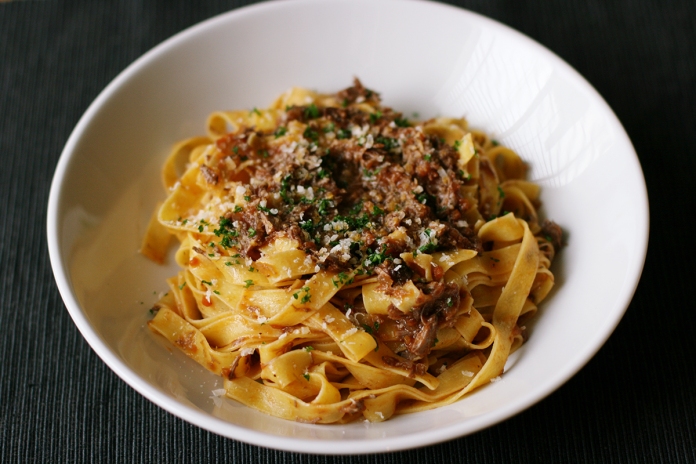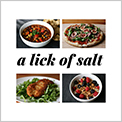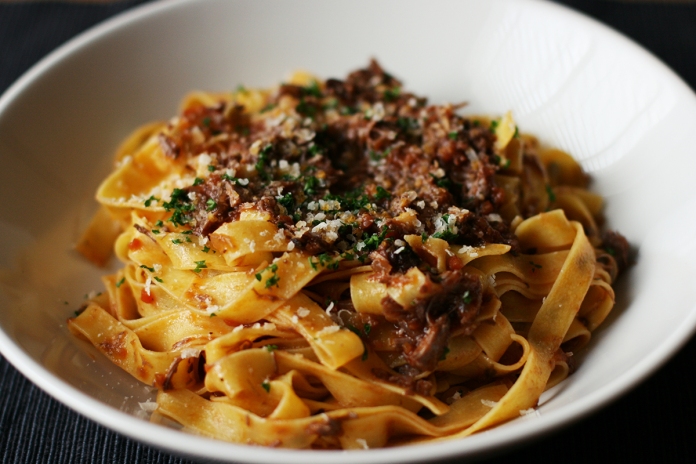This is a very lovely meal to make for people you love very much because it takes forever. But it is very much worth it, and if there’s just two of you, you get to enjoy not one but two leftovers!
As tends to be the case with sauces, this tastes better the next day, so you can make the ragu with a full belly and then all you’ll have to do the next day is heat it up and cook the pasta. You can enjoy a quick but decadent dinner even on a weekday!
The recipe is written to be leftover friendly. Cook only the pasta you need on the day you’re having it (step 11), and combine it with as much sauce as each person desires, directly into each plate.
Also written into the recipe is one way in which to prevent the pasta from hardening and sticking together: combining it with a little bit of sauce. This is a less photogenic option than adding the sauce to the bare pasta at the dinner table but I personally think this is a photogenic sacrifice that is worth making. I’ve also heard you can prevent the pasta from hardening by running it under cold water and then under hot water again to heat it back up, which I’ve tried but was not happy with because I couldn’t get the pasta to get hot enough. And I’ve read that you can instead combine the pasta with some olive oil, but I have not tried this because I’m worried it would become too greasy. #pickyeaterproblems
This dish would be even more lovely with homemade pasta. I use the next best thing, egg pasta imported from Italy. I still use the Filotea brand that I buy from the World Market section of my local Bed Bath & Beyond. I did run out and tried a pasta that was still imported from Italy but was 100% semolina for a set of portions and I’m sorry to say that I was disappointed. You likely need to add quite a bit of salt to the water when making non-egg pasta to have it taste good, and I don’t know enough about the chemistry to know how adding salt to the water affects the sodium content of the dish.
I made this first for a surprise birthday dinner for my husband and then it took a year for duck legs to come back in stock at Whole Foods so I could remake it. I loved it the first time but there’s just something about the novelty of making something that’s time-intensive for the first time that prevents me from being able to be objective. Second time around, the ragu is still delicious and since the recipe yields 6 portions, the amount of time and effort it takes feels more worth it.
Low-sodium braised duck and red wine ragu pasta
Adapted from Debi Mazar & Gabriele Corcos’ recipe ‘Pappardelle with duck ragu’ from Extra Virgin: Recipes & Love from Our Tuscan Kitchen

Serves 6
Ingredients
- 2 tablespoons extra virgin olive oil (30 mL)
- 4 whole duck legs (drumsticks and thighs together)
- freshly ground black pepper, to taste
- half a red onion, finely chopped
- 1 celery stalk, finely chopped
- 1 carrot, finely chopped
- 3 sprigs fresh thyme
- 1 garlic clove, finely minced
- 1 1/2 cups red wine (355 mL)
- 1 28-oz can whole peeled tomatoes, pureed in a blender (794 g)
- 19.8 oz uncooked Tagliatelle or other thick pasta (563 g, 3.3 oz/94 g per portion)
- Finely chopped parsley, for garnish
- Freshly grated parmigiano-reggiano cheese, for serving (1 teaspoon per portion)
Directions
- In a large skillet, heat olive oil over medium-high heat until it is hot.
- Season the duck legs with freshly ground pepper. Place them in the pan and cook them, turning them occasionally, until the skin is evenly browned and crisp, about 10-11 minutes. Transfer the seared duck legs to a clean plate and set it aside. Retain the duck fat and oil in the skillet.
- Stir the onion, celery, and carrot in to the skillet and cook, stirring occasionally, until the vegetables soften, about 3 minutes.
- Add in the thyme and garlic and sauté until they become fragrant, about 1 minute.
- Stir in the red wine with a wooden spoon, scraping up any burnt bits from the bottom of the pan. Cook for about 2 minutes.
- Add in the pureed tomatoes. Season with freshly ground pepper to taste.
- Bring the sauce to a boil, then reduce the heat and bring the sauce to a light simmer. Add the seared duck back in and cover the skillet. Simmer gently until the duck is tender and falls off the bone, about 1 hour and 30 minutes. Turn the duck legs once midway, at the 45 minute mark. Remove the skillet from the heat once the duck is tender.
- Using tongs, remove the duck from the skillet onto a heat-resistant cutting surface. Carefully remove the skin and detach the meat from the bones. Discard the skin and bones. Chop the duck meat finely, finely enough that it don’t taste stringy to you. Have a taste!
- Stir the duck into the tomato sauce. Add in half a cup of water if the ragu looks dry (I didn’t need it).
- Cover the skillet and bring the mixture to a simmer over medium-low heat. Cook for an additional 40 minutes.
- While the ragu is in its last looking stage, cook the pasta so it is ready at the same time as the ragu.
- Drain the pasta and divide it into individuals portions, working quickly to combine each portion with enough sauce to prevent the pasta from hardening or sticking together. Scoop additional ragu onto each portion, as much as each person desires. I don’t like to skimp on the sauce, for example.
- Sprinkle each portion with parsley, to taste, and 1 teaspoon parmesan. Serve immediately.
Tips
Sources of sodium
- Tomatoes
- Duck
- Pasta
- Parmesan cheese
- Wine
- Carrot
- Celery
Approximate sodium intake per serving: 448.5 mg
- 240 mg from the tomatoes, which have 220 mg per 1/2 cup (121 g)
- 81 mg from the duck, which has 122 mg per leg
- 76.5 mg from the pasta, which has 51 mg per 2.2 oz (62.5 g)
- 25 mg from the parmesan cheese, which has 433 mg per oz (28.4 g)
- 12 mg from the wine, which has 1 mg per fl oz (30 mL)
- 7 mg from the carrot, which has 69 mg per 100 g
- 7 mg from the celery stalk, which has 80 mg per 100 g
- These values are calculated from the nutritional labels of the ingredients I used
Modifications
-
Reduce the sodium
I used SMT (San Marzano) canned tomatoes that have salt added. You can reduce the sodium by choosing no-salt added whole tomatoes or, if unavailable, no-salt added crushed tomatoes which you could still puree. If I’d used the Simple Truth Organic brand, for example, each portion would have had only 251.5 mg of sodium because those tomatoes would have only added 43 mg.
The egg pasta also has some sodium. Pastas that aren’t made with eggs usually don’t have any sodium but they’re less tasty if you don’t salt the water as they cook. I personally also need to dress up non-egg pasta with a lot more sauce.
-
Increase the sodium
If you aren’t watching your sodium intake:
- Season the duck legs with salt before searing them (Step 2)
- Add salt to the sauce when you add in the tomatoes (Step 6)
- Salt the water when you boil your pasta (Step 11)
- Sprinkle each dish with more parmesan cheese (Step 13)
Adding 1/4 teaspoon of sea salt to the whole dish adds 98 mg of sodium to each portion (for a total of 546.5 mg).
-
Tagliatelle pasta
We like Filotea brand pasta, which is available online at Amazon.com but we get ours for less at our local Bed Bath & Beyond, which has a large World Market
section. The pasta retails there at $4.99 per box, but I’m a thrifty shopper and I almost always get it for less with store coupons and in-store cashback from Ebates. We need about 3/8 of a package per person so for six dinner servings, we use 2 1/4 boxes of pasta.
Handy tools
12″ Deep Skillet with Lid
I use a 11 3/8″ stainless steel skillet. The inside measures about 10.25″ at the top and it’s about 2.5″ deep. It’s almost a little too small, so a deep 12″ skillet with a lid should work perfectly.
12″ Tongs with Silicone Heads
I love these tongs, they’re indestructible because they’re hard stainless steel coated in silicone and they don’t scratch any surfaces. I have two of them, one of which I’ve had for 5 years and is still in great shape.
Did you make this?
- If you recreate this recipe, I’d love to know! Leave a comment here and tag @alickofsalt on social media.








I love duck. That looks delicious.
LikeLiked by 1 person
Thank you, it also tasted delicious to us! 🙂
LikeLiked by 1 person
Oh I believe you. It looked so good I licked the screen and I think I got a little hint of the flavor! 😛😋
LikeLiked by 1 person
Hahaha, I had no idea my pictures could cross perceptual dimensions!
LikeLiked by 1 person
it looks soo good. I love pasta:) thanks for sharing the recipe
LikeLiked by 1 person
I know, right? Especially egg pasta, it’s so good! Thanks for writing!
LikeLike